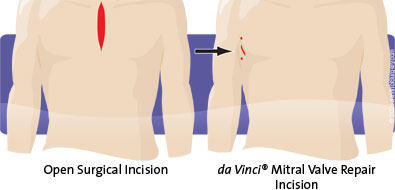Non-Invasive Heart Valve Repair Using A Robot
Heart valve surgeons are now routinely performing videoscopic minimally invasive heart mitral valve repair surgery, also known as non-invasive heart valve repair.

Performed through a two-inch keyhole incision on the side of the chest, this approach avoids an incision in the breastbone and is intended to allow patients to return to work and everyday activity sooner after surgery.
Robotic Heart Valve Repair Compared To Traditional Surgery
Traditional mitral valve repairs involve cutting open the breastbone to repair the heart valve. Now, many cardiothoracic surgeons are offering a new, minimally invasive option known as videoscopic minimally invasive mitral valve repair. Robotic techniques have been pioneered by companies including Da Vinci Surgical Systems.
The procedure is performed through a two-inch keyhole incision on the right side of the chest. This approach avoids an incision in the breastbone or ribs and may accelerate patient recovery in some patients.
To learn more about the advantages of robotic heart valve repair, I interviewed Dr. Vinay Badhwar, the Chief of Cardiac Surgery at WVU Medicine in Morgantown, Virgina. Here are the highlights of my interview.
Other advantages of videoscopic minimally invasive mitral valve repair include a lower likelihood of receiving a blood transfusion, and earlier discharge from the hospital. Also, reports suggest there is a lower risk of infection using the non-invasive heart valve repair. However, this procedure is not suitable for all patients with heart valve disorders.
You Might Also Like
To help you learn more about heart valve repair, here is additional medical information and patient stories:
- Heart Surgery Innovation: Robotic Mitral Valve Surgery Evolution
- New Finding: Mitral Valve Repair Restores Life Expectancy
- Surgeon Q&A: When Should the Mitral Valve Be Repaired?
- Free Patient eBook: Advantages of Mitral Valve Repair
Page last updated: September 18, 2020




